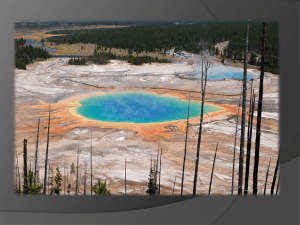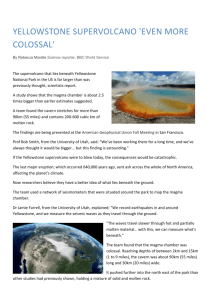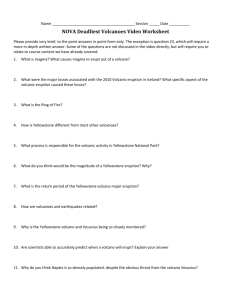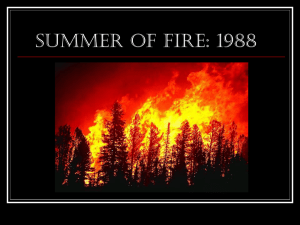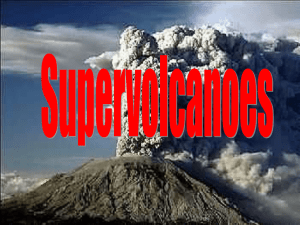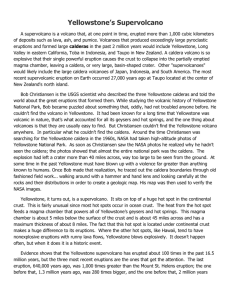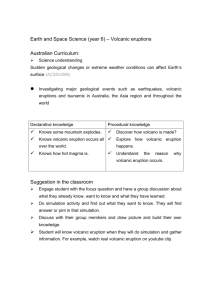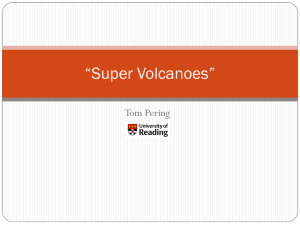File - McKenzie Redberg
advertisement
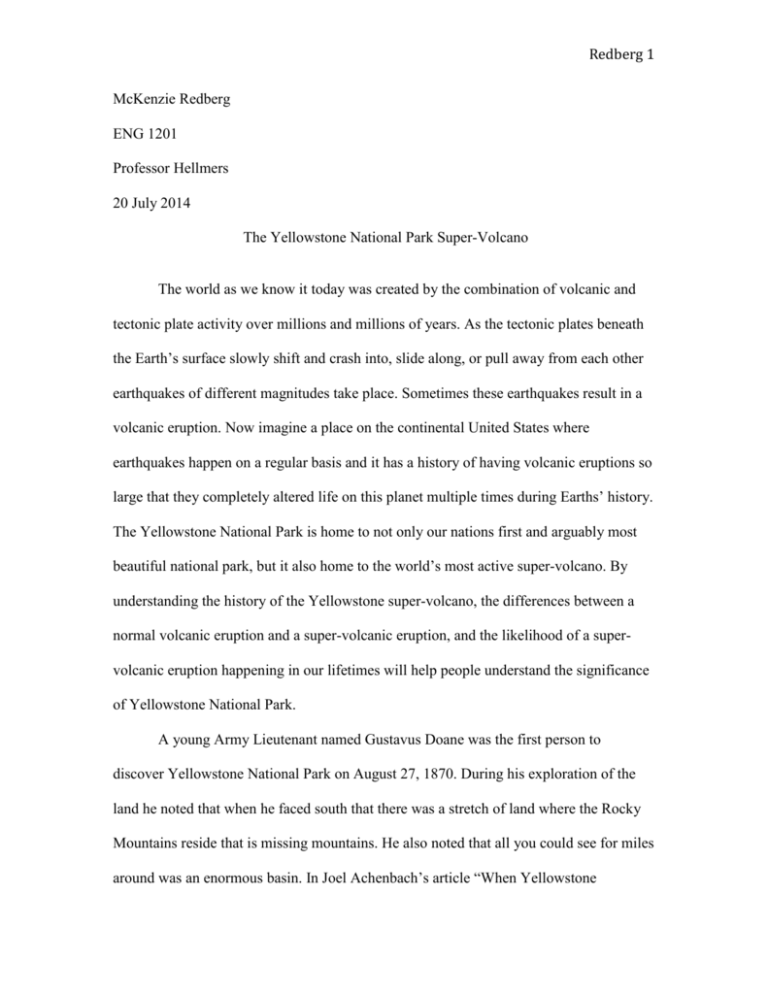
Redberg 1 McKenzie Redberg ENG 1201 Professor Hellmers 20 July 2014 The Yellowstone National Park Super-Volcano The world as we know it today was created by the combination of volcanic and tectonic plate activity over millions and millions of years. As the tectonic plates beneath the Earth’s surface slowly shift and crash into, slide along, or pull away from each other earthquakes of different magnitudes take place. Sometimes these earthquakes result in a volcanic eruption. Now imagine a place on the continental United States where earthquakes happen on a regular basis and it has a history of having volcanic eruptions so large that they completely altered life on this planet multiple times during Earths’ history. The Yellowstone National Park is home to not only our nations first and arguably most beautiful national park, but it also home to the world’s most active super-volcano. By understanding the history of the Yellowstone super-volcano, the differences between a normal volcanic eruption and a super-volcanic eruption, and the likelihood of a supervolcanic eruption happening in our lifetimes will help people understand the significance of Yellowstone National Park. A young Army Lieutenant named Gustavus Doane was the first person to discover Yellowstone National Park on August 27, 1870. During his exploration of the land he noted that when he faced south that there was a stretch of land where the Rocky Mountains reside that is missing mountains. He also noted that all you could see for miles around was an enormous basin. In Joel Achenbach’s article “When Yellowstone Redberg 2 Explodes” he quotes Lieutenant Doane stating, “the great basin has been formerly one vast crater of a now extinct volcano” (Achenbach/Doane). Turns out that Lieutenant Doane was half right. Yellowstone is in fact the site of a massive volcano, however; it is far from extinct. Figure 1 illustrates what the Yellowstone basin looks like and how magma feeds into the mantle. The Yellowstone super-volcano is unique in a way that is only due to its size, but to its movement as well. This super-volcano was created due to a “hotspot”. Hotspots are places in the Earth’s surface where it was cracked and allows magma from the Earth’s core to pool underneath the crust. This means that as the tectonic plates shift, the hotspot stays in the same place. Mr. Achenbach argues that evidence of prior eruptions are scattered across the western side of the United States: “The ‘hot-spot’ responsible for the Yellowstone caldera has erupted dozens of times in the past, going back some 18 million years. Since the hot spot is rooted deep in the Earth, and the tectonic plate above it is moving southwest, ghostly calderas from the more ancient explosions are strung out like a series of gigantic beads across southern Idaho and into Oregon and Nevada, the subsequent lava flows forming the eerie moonscapes of the Snake River Plain.” (1) Redberg 3 Fig. 1 depicts the Yellowstone Caldera (basin) as well as the hot spot coming up from the Earth’s core. Figure 2 depicts the most recent eruptions and shows the path in which as lead Yellowstone to be where it is located today. Achenbach also stated that Yellowstone has the three most recent super-volcanic eruptions with the most recent being only 640,000 years ago, which left a basin 45 miles across; its most devastating eruption was 2.1 million years ago, which left a hole in the ground the size of Rhode Island. To better understand what it’s history means, we must first understand the difference between a normal volcanic eruption and a super-volcanic eruption. Fig. 2 shows a map of the most recent eruptions of the Yellowstone Hot-spot. When Mount St. Helens erupted in 1980, 57 people lost their lives, countless more lost their homes, and hundreds of thousands of people were affected by the blast, ash, and flash floods that came with it. One difference between a normal volcanic Redberg 4 eruption like Mount St. Helens and a super-volcanic eruption is obviously the pure size of it. In Matt Volz’s article “Yellowstone Volcano’s Magma Is Much Bigger Than Previously Thought, Study Finds” he states “the molten rock beneath Yellowstone National Park is 2 ½ times larger than previously estimated, meaning the park’s supervolcano has the potential to erupt with a force 2,000 times the size of Mount St. Helens” (p. 1). According to Richard Lovett’s article “Yellowstone Supervolcano Discovery-Where Will It Erupt?” he states “ the Yellowstone region is often referred to as a "supervolcano" because it has spewed more than 240 cubic miles (a thousand cubic kilometers) of ash and lava in a single event.” A study completed by the USGS: Volcano Hazards Program Yellowstone Volcano Observatory, completed on June 25, 2014 started using seismic tomography to map the size of the magma chamber (p. 1). Their results supported the claims of Volz. The exact measurements of these studies were astounding. According to Volz they found the caldera to be 55 miles long, 18 miles wide, and stretching to the depths of 3-9 miles below the Earth’s surface (p.1). “There is enough volcanic material below the surface to match the largest of the supervolcano’s three eruptions over the last 2.1 million years” (Volz). Ultimately Joel Achenbach said it best, “volcanoes form mountains; supervolcaneos erase them. Volcanoes kill plants and animals for miles around; supervolcaneos threaten while species with extinction by changing the climate across the entire planet” (p. 1). Another distinct difference between normal volcanoes and super-volcanoes is the external triggers that create an eruption. Normal volcanic eruptions are due to the combination of magma build up and a large enough earthquake to set them off. In Ryan Grenoble’s article “Supervolcanoes Can Erupt ‘Spontaneously,’ Researchers Say” he Redberg 5 follows a research project called the European Synchrotron Radiation Facility where they study external factors that lead to super-volcanic eruptions. Their results startled them. The answer? None. No external factors are necessary to set off a super-volcanic eruption. “A supervolcano can erupt due to its enormous size alone…once you get enough melt, you can start an eruption just like that” (Grenoble). According to the National Park Service there are 1,000 to 3,000 earthquakes per year at Yellowstone National Park (p. 2). So not only does a super-volcano not need an external trigger to cause an eruption, it has the help of regular earthquakes to potentially make it a little easier. All this information makes Yellowstone sound like it is literally a ticking time bomb. The fact of the matter is, is that it is a ticking time bomb. However, what is the real likelihood of it erupting in our lifetimes? In Liz Fuller-Wright’s article “Yellowstone Bison Fleeing Impending Supervolcano? No.” she searches for the truth in response to the YouTube video “ALLERT! Yellowstone Buffalo Running for Their Lives!”. The video in question had over a million views in a very short amount of time and spread across the Internet like wildfire. In the video, you see a small herd of bison running down a paved road inside Yellowstone National Park rumored to be running away from an impending eruption. The reality of the situation was that these bison were migrating more inland in search for food. “Bison are indeed walking out to places that their herd memory tells them may offer a chance of food that’s easier to get at and perhaps fresh green food, but what we also know is, as the snow melts and things green up at elevation, they’ll walk back in” (Fuller-Wright). The rumor over the fleeing bison due to an impending eruption was false, but there are other factors that need to be taken into account as well. Redberg 6 Yellowstone National Park is the most active super-volcano in the world and appears to be becoming even more active over the recent years. Joel Achenbach states “the odds of a full, caldera-forming eruption- a cataclysm that could kill untold thousands of people and plunge the world into a volcanic winter- are anyone’s guess; it could happen in our lifetimes, or 100,000 years or more form now, or perhaps never” (p. 3). He later goes on to state, “For most of its history, the Yellowstone hot spot has formed calderas in the thin crust of the Basin and Range area of the American West. Now the hot spot is lodged beneath a much thicker crust at the crest of the Rockies” (p. 3). A thick crust would make it challenging for a full-fledged super-volcanic eruption to take place. In addition, Ryan Grenoble goes on to state in his article that the probability of a Yellowstone eruption is 0.00014 percent (p. 1). By better understanding not only the history of the Yellowstone super-volcano, but the differences between a normal volcanic eruption and a super-volcanic eruption, and the likelihood of a super-volcanic eruption taking place in our lifetimes will better educate the public on the significance of Yellowstone National Park. Though it seems the park seems to have no immediate threat, it is important for all of us to be aware of what the future might hold. Yellowstone will continue to be our nation’s first, arguably most beautiful, and one of the most visited national parks in the United States. Hopefully the impending threat of an eruption is in our very distant future so the joys of the park can continue to live on. Redberg 7 Works Cited Lovett, Richard. "Yellowstone Supervolcano Discovery-Where Will It Erupt?" National Geographic. National Geographic Society, 20 Sept. 2012. Web. 12 July 2014. <http://news.nationalgeographic.com/news/2012/09/120920-yellowstone-s upervolcano-p rediction-volcanoes-science-environment/>. Redberg 8 "U of U Seismology and Active Tectonics Research Group." U of U Seismology and Active Tectonics Research Group. Photograph. 27 July 2014. <http://www.uusatrg.utah.edu/>. Web United States. National Park Service. "Volcano Questions & Answers." National Parks Service. U.S. Department of the Interior, 10 June 2014. Web. 05 July 2014. < http://www.nps.gov./yell/naturescience/volcanoqa.htm>. "USGS: Volcano Hazards Program Yellowstone Volcano Observatory." USGS: Volcano Hazards Program Yellowstone Volcano Observatory. 1 Apr. 2014. Web. 05 July 2014.<http://volcanoes.usgs.gov/observatories/yvo/>. Volz, Matthew. "Yellowstone Volcano's Magma Is Much Bigger Than Previously Thought, Study Finds." The Huffington Post. TheHuffingtonPost.com, 18 Dec. 2013. Web. 05 July 2014. <http://www.huffingtonpost.com/2013/12/18/yellowstone-volcano magma_n_4467243.html>. "What Will Really Happen When the Yellowstone Supervolcano Erupts?" Photograph.27 July 2014. <http://io9.com/what-will-really-happen-when-yellowstone-volcanohas-a-508274690>. Web.
